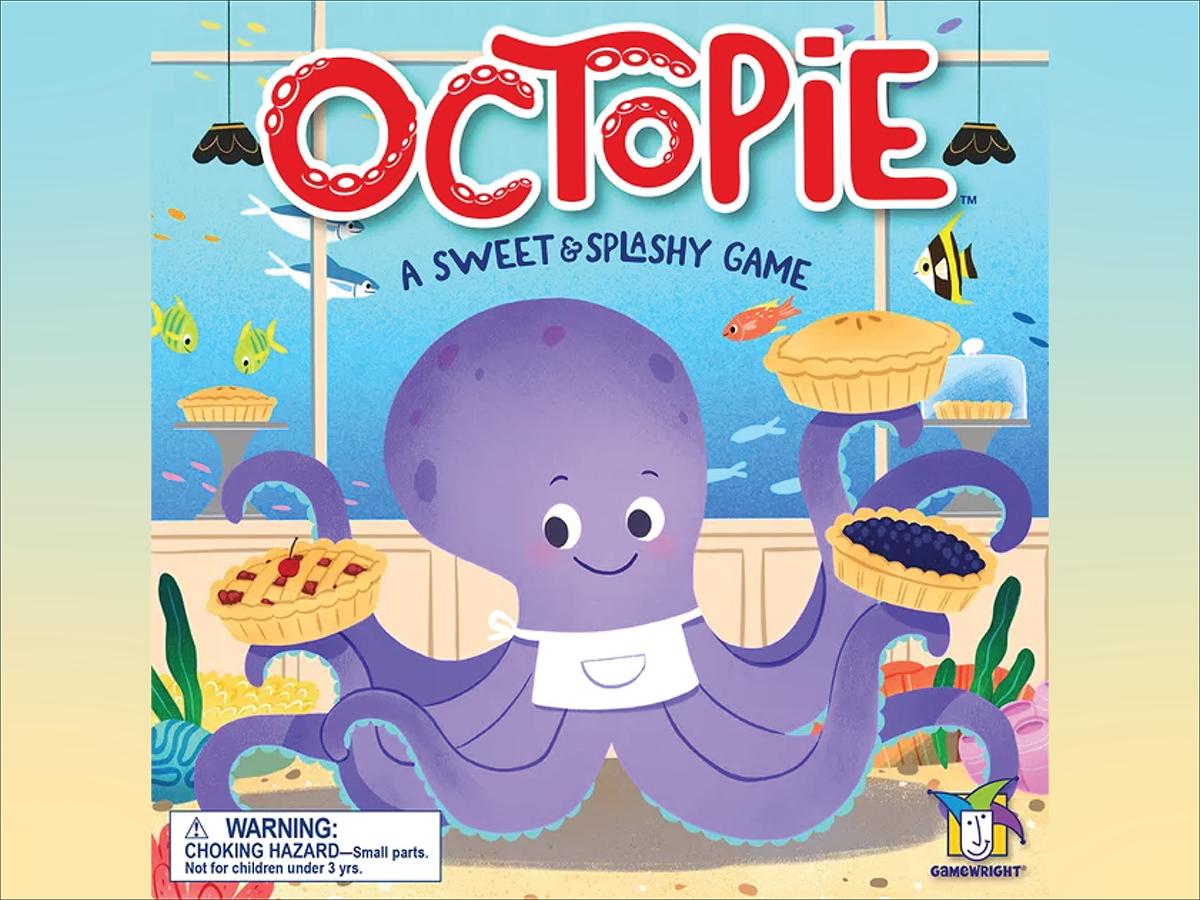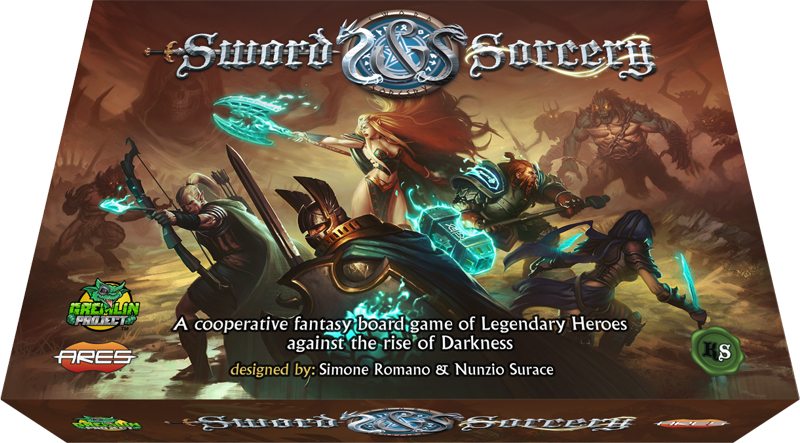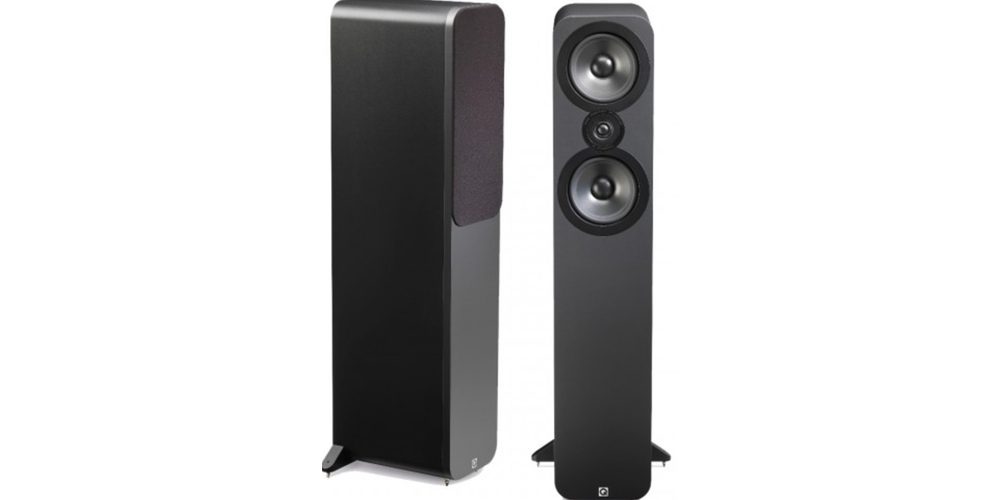Roll the chunky die, gather tentacle tiles, and collect special octo-pies to meddle with your opponents—the first player to eight tentacles of the same color wins!
What Is Octopie?
Octopie is a kid-friendly, set collection game for 2-4 players, ages 5 and up, that takes about 15 minutes to play. The game retails at $17.99 and is available both online via the Gamewright website and at local retailers. The gameplay, as is the case with many Gamewright titles, is designed to reinforce critical skills for the 5+ age group, including fine motor skills and visual discernment.
Octopie was designed by Rosie and Henry Roberson, with illustrations by Bonnie Pang, and was published by Gamewright.
Octopie Components
- 50 double-sided tentacle tiles
- 15 pie tokens
- 4 octopus heads
- 1 six-sided die
- 1 rulebook
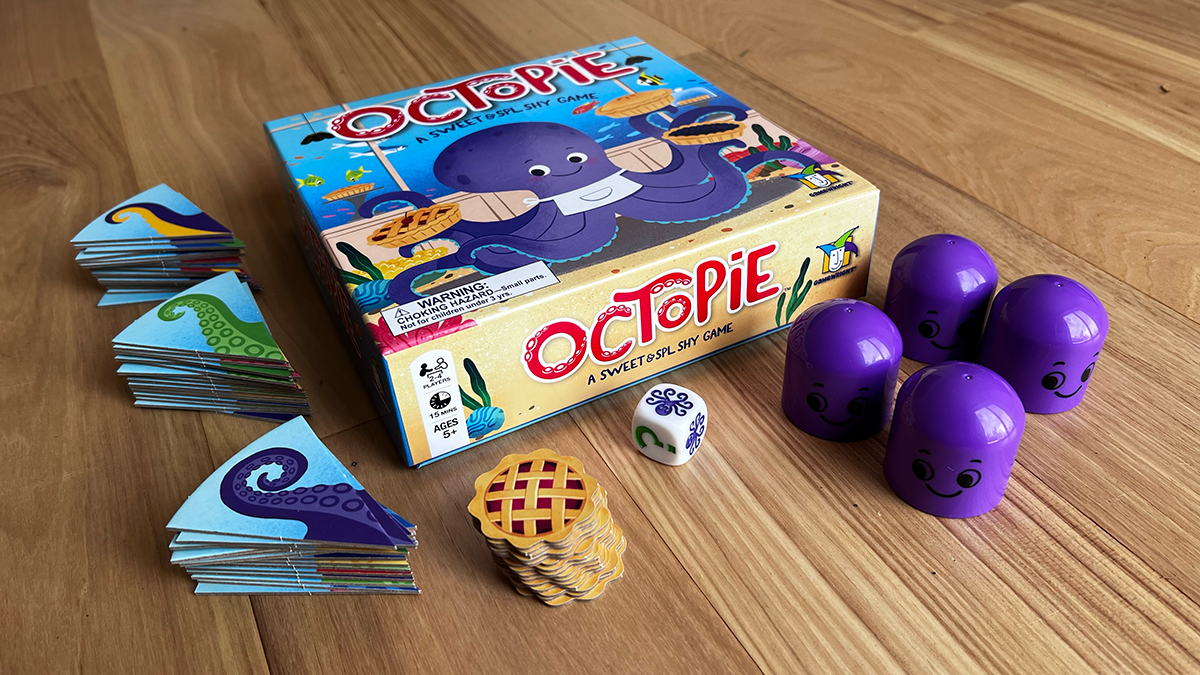
Right off the bat, Octopie really does a great job of achieving the “toy factor” that lends to the popularity of most games in this same category. The purple octopus head, for example, adds no strategic value to the game but with a cute face that can double as a dice-rolling cup, it has a certain tactile nature that makes the game more inviting, especially to the younger demographic.
The tentacle tiles and the pie tokens are a standard thickness of cardboard (fun to punch out with your little ones!) and the die is oversized to accommodate smaller hands. The symbols on the die are bright and easy to differentiate from one another, with a detailed description of each one on the first page of the rulebook.
Speaking of the rulebook, the publisher has done a great job of making it visual and concise. The rules themselves take up less than two pages, with detailed illustrations and a Spanish translation on the back side, while still leaving room for a cheeky note about the origin of the game’s name towards the end. The illustrations in the rulebook carry over onto the box art and really make this one stand out on the shelf. Octopie is bright, it’s colorful, and it’s easy to learn—that’s a great start. But how does it play?
How to Play Octopie
You can download a copy of the rulebook here.
The Goal
The goal of Octopie is to be the first player to complete an octopus by assembling a circle of 8 Tentacle tiles underneath their purple octopus head that all share the same color. This may include solid Tentacle tiles or ones with two colors as long as one of the two colors matches the rest of the set. Once this task is completed, the game ends immediately and that player wins!

Setup
The setup for Octopie is as simple as 1-2-3! First, you’ll shuffle all of the Tentacle tiles together and separate them into three stacks that are roughly the same height. Each Tentacle tile is double-sided so don’t worry about concealing any information during the shuffle—the rulebook didn’t mention anything about the distribution of the colors, but if you’re worrying about distribution in a game like this, you might be missing the point…

Secondly, after you’re done shuffling the Tentacle tiles, grab the stack of Pie tokens, mix those up, and place them in a stack over to the side of the play area. Then thirdly, once all of the stacks are made, you’ll pass out a purple Octopus head to each of the players and place the die within reach of everyone. Whoever was the last person at the table to eat pie gets the honor of being the first player. Now it’s time to start fishing for Octopie!
Gameplay
In the first round of Octopie, players will all take the Draw action to ensure that everyone has one Tentacle tile to build off of. After play has circled around once, players’ actions will now be determined by the roll of the die.
There are four possible actions available on the die. If you roll the purple octopus icon, you’ll take the Draw action and add one Tentacle tile from the stack to your own octopus. It’s important to note that when you draw a Tentacle tile, even though they are double-sided, you cannot flip the tile or peek at the other side. However, the colors of the tentacles are never repeated from one side to the other so that can at least help you narrow down your guesses.
The next action is Flip, represented by a blue wedge with an arrow. This action allows you to flip over any one Tentacle tile anywhere in play. This means that you can flip one of your own Tentacle tiles to adjust its color, you can flip over the Tentacle tile of an opponent to mess with their best-laid plans, or you can flip a Tentacle tile on the top of one of the stacks to try to reveal something new.
The third action is Swap, indicated by the two yellow wedges (that look suspiciously like tortilla chips) with an arrow in between them. The Swap action allows a player to trade out one of their acquired Tentacle tiles with either a Tentacle tile from an opponent or one from the top of the stack. This can be a pretty devious and strategic action if you see a rival octopus getting close to the finish line!

The fourth and final action you can take is the Wild action, represented by the green question mark. This action simply allows you to take your choice of the three aforementioned actions on your turn. All in all, the actions are really easy to grasp and the icons are visually informative. Since there are three purple octopus icons on the die as opposed to one each of the remaining icons, it’s likely that you’ll be taking the Draw action the most. It should be noted then that you can only ever have 8 Tentacle tiles under your octopus at a time. If you should ever have to take an action that would force you to have 9, you must immediately discard one Tentacle tile of your choice from your play area and place it on the bottom of one of the stacks.
Now that we’ve covered the “OCTO” part of this game, let’s talk about the “PIE” part! You may have noticed that there are a select few Tentacle tiles that are wrapping themselves around a delicious pie. If at any time during the game you acquire a Tentacle tile with a pie on it, whether by flipping over one of your tiles and revealing it or by adding it from the stack or from another player, you may immediately draw a Pie token from the stack. You may choose to keep the bonus on the Pie token secret if you’d like, although sometimes it’s good to keep it face up so that other players don’t want to mess with you.
Typically, Pie tokens act as bonus actions and will allow you to take an extra action on your (or somebody else’s) turn. You can only play one of these Pie tokens per turn and you can only ever have two of them at a time. If you were to acquire a third, you must either play or discard one of your current Pie tokens before you take it. The actions on the Pie tokens are as follows:

The purple octopus icon does the same as the die and allows you to take an extra Draw action on your turn. The token with the Swap and Flip icons on it and a squiggly line running through the center of it will allow you to do one of those two actions as if you had rolled it on the die. The next three token types however are not shown anywhere else.
The first is a green fishhook icon which lets you take a Steal action. When taking the Steal action, you have to choose to take a Tentacle tile of your choice from an opponent, which means that you don’t have the option to take the high road and “steal” from the tile stack. Next up is a red net icon representing the Block action. The Block action is the only Pie token that can be used on another player’s turn but can be used immediately if someone is trying to steal from or swap with you.
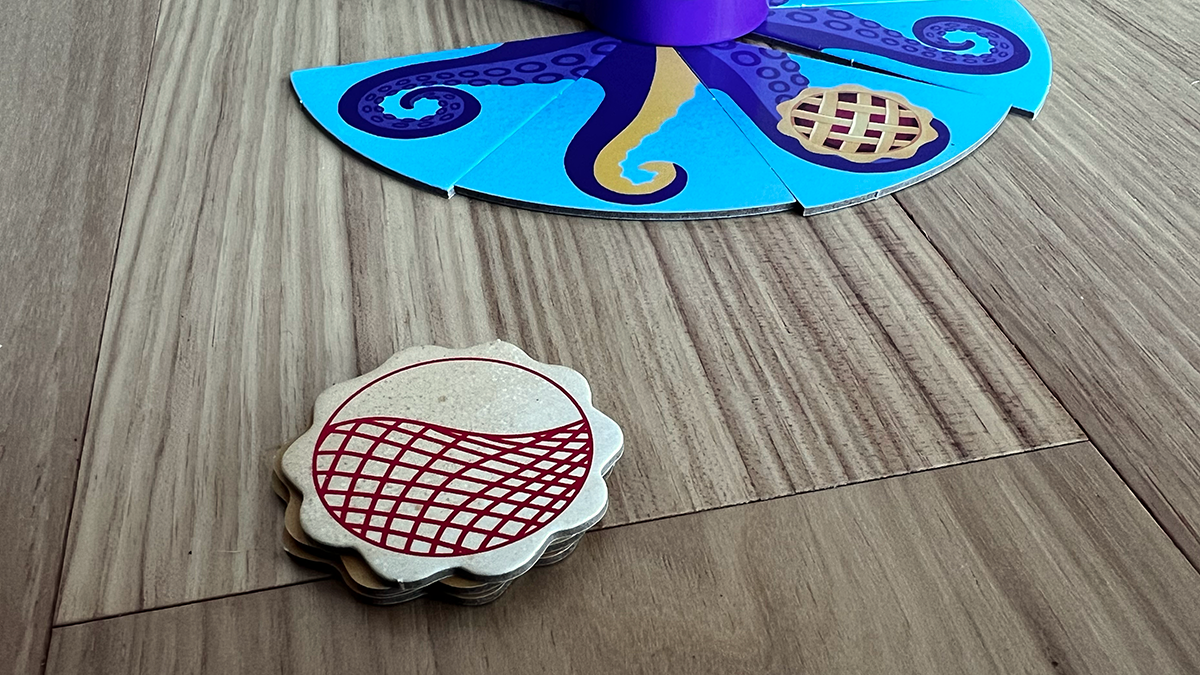
The last Pie token has a blue tidal wave on it which will grant you the Re-roll action. If you don’t like your die result on your turn, play this wave token to get a second chance! If at any point, the Pie token stack runs out, simply reshuffle any played Pie tokens and make a new face-down stack.
Game End
After several turns of maneuvering Tentacle tiles and sabotaging your opponents, as soon as one player manages to complete an octopus with tentacles that are all the same color, the game is over and they win! And the nice part about a turn-based race to the finish is that there’s no tiebreaker necessary.
Why You Should Play Octopie
Octopie was a blast and, even though this game was certainly created for a younger demographic, I can confidently say that I enjoyed the gameplay just as much as the younger folks I’ve played it with! This game has a lot of things going for it both from an educational standpoint and a gameplay standpoint so let me share my thoughts.
The first thing that I’ll mention is that I love that this game is language-independent. As long as you have a parent or designated older player to explain the rules, I feel like this game would be a breeze to pick up well before the suggested age of 5+. The icons in the game are so clear and easy to recognize that it makes teaching and learning Octopie a walk in the park.
The toy factor in this game as well really adds to the experience. The cute illustrations and fun octopus heads really make this game inviting to kids and make it one that sticks in their minds so that, when they are trying to decide which game they want to play, “the octopus one” is a no-brainer.

From a gameplay perspective as well, I was pleasantly surprised! After going through the rules, I was expecting there to be more “take-that” moments, since there are several actions that allow you to mess with your opponents. But after playing it, the game goes so quickly and has enough chaos flying around that you’ll end up spending more time focusing on your own octopus rather than foiling your rivals’ plans.
I also appreciate the simplicity of the race-to-the-finish ending. Generally in my experience, the complexity of the win conditions is the biggest indicator of accuracy within the suggested age range and because of Octopie’s simplicity, I’m confident that kids younger than 5 would both comprehend and enjoy this game.
All in all, Octopie is a fantastic kids’ game and it’s one that I look forward to playing with my 2-year-old in due time. As of now, he’s mostly just interested in the big chunky die, but I hope that soon he’ll be excited by the clever mechanics of it as well. For me though, Octopie is just another example of how Gamewright really has its finger on the pulse of their consumer and understands exactly how to make games for the younger demographic. So if you’re looking for a solid, kid-friendly game with an adorable theme and some really fun gameplay that can keep both children and adults entertained at your next game night, then might I suggest Octopie?
For more information about Octopie, visit Gamewright’s website.
Click here to see all our tabletop game reviews.
![]() To subscribe to GeekDad’s tabletop gaming coverage, please copy this link and add it to your RSS reader.
To subscribe to GeekDad’s tabletop gaming coverage, please copy this link and add it to your RSS reader.
Disclosure: GeekDad received a copy of this game for review purposes.
